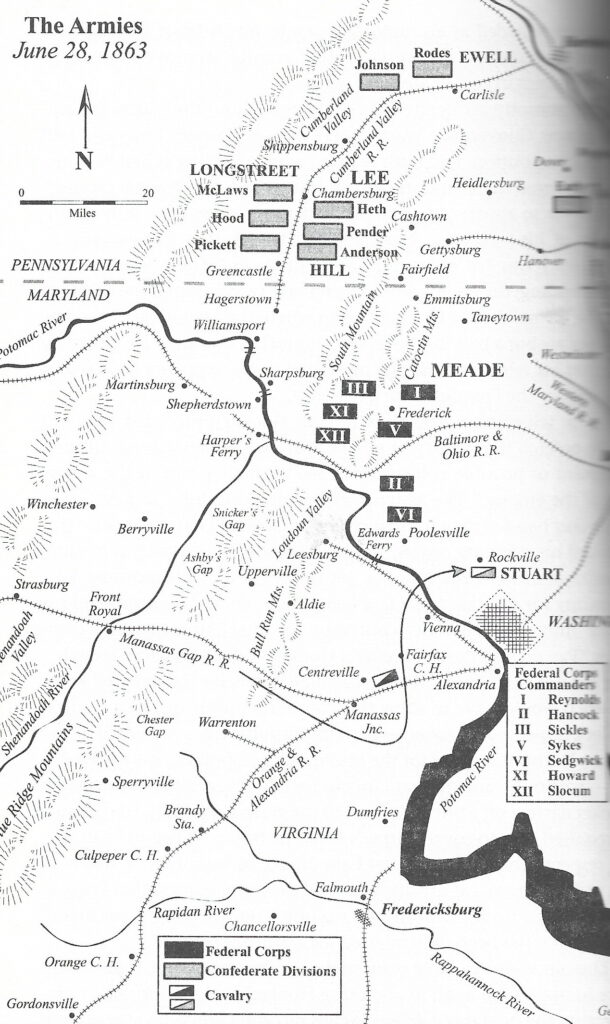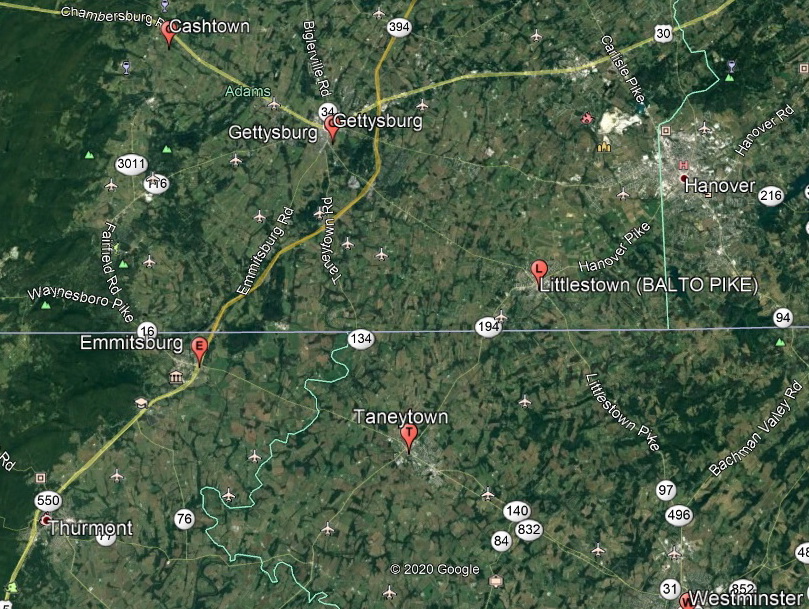In Section 4a I described how LTG Ewell’s 2 divisions ended up at Carlisle with his third division under MG Early at York, PA. Lee’s initial objective was to capture Harrisburg. Certainly, the loss of a State Capitol would have been a major blow to the Union cause – politically if not militarily. But would the capture of Harrisburg have truly brought pressure on President Lincoln to end the war? Lee’s Army would have been essentially trapped hundreds of miles inside Union territory with no possibility of relief or re-enforcements. The Union forces could simply have laid siege to his island of the Confederacy; possibly near Dillsburg.
So I’d like to explore a scenario where Lee simply concentrates on threatening Baltimore and WASHDC and not the PA State Capitol. Using the timeline documented by the historians, Ewell’s Corps could have been at Gettysburg as early as 26 June. Per the attached map, Hooker was really just beginning to react to the Potomac crossing. No Union forces where even as far north as Frederick MD. Hooker only had the vaguest idea precisely where the Army of Northern Virginia was.

One thing that has always baffled me was the lack of targeting of Westminster by Lee. During that last week of June, it had not yet become the supply hub that it soon would be. Hooker’s Army was still far to the south and west. Yet any map would have told Lee that of all the places in the immediate area, Westminster was the prize. Yet, it hardly gets a passing consideration as a strategic goal as documented by Sears and Coddington.
JEB Stuart’s Cavalry was just outside of Westminster on 29 June as he was trying to find a safe route back to Lee to deliver the Union supply wagons that he had captured. But he seemingly never gave a city the second glance. At the same time that Reynolds’ First Union Corps was approaching Frederick, Stuart made his way north through Union Mills up to Littlestown on the Balto Pike. On June 30, Slocum’s Sixth Corps passed through Westminster and took up a blocking position at Manchester to the NE. Another seeming tactical failure was that Stuart never touched the Western Maryland RR that entered Westminster from the south. That rail line would become critical in funneling supplies to Westminster from Baltimore under the direction of BG Haupt, the Army’s Railroad Chief. This in itself is unusual because cutting telegraph lines and destroying Union rail roads were something that Stuart was renowned for doing.

For their part, first Hooker then Meade seemed to have a greater appreciation for the strategic importance of Westminster. With Slocum at Manchester on the right flank, Reynolds was dispatched to Emmittsburg to establish a left flank. Taneytown (just north of Pipe Creek) would anchor the center of the Union line. Meade recorded an order that BG Gregg’s cavalry (part of Sykes’ Fifth Corps) “secure the rail terminus at Westminster”. Once Hooker’s staff officer chose Pipe Creek as the best defensive position in the region, Westminster rose in its importance as a supply hub as a well as a portal to Baltimore that needed to be defended. It was barely a day’s march to the northern outskirts of Baltimore.
Once again, playing out the WHATIF of Ewell occupying Gettysburg on 26 June, Lee would have had plenty of time to re-direct A.P. Hill’s Corps south from Cashtown to at least Fairfield if not all the way to Emmittsburg. Reynold’s wouldn’t arrive there before the 29th! Over the course of those 3 days, Lee could also have sent a division from Ewell to approach Taneytown. Lee still was unsure of how far north the Union Army had managed to march.
So for Lee the chess pieces at the end of June were laid out so: Stuart at Littlestown on the Balto Pike in the east; Ewell moving from Gettysburg to Taneytown in the center and Hill at Emmittsburg in the west. Longstreet was still some distance back. The newly appointed Meade would have had no choice but to invoke Hooker’s Pipe Creek Circular and establish the 18 mile line from Manchester to Middleburg overlooking the creek.
Most of these facts and the timeline above come via Coddington’s scholarly work. Sears pays much less attention to Westminster in his book, but what is there echoes Coddington. Obviously, they were using many of the same source documents.
If even a portion of Ewell’s Corps had been seen in the vicinity of Taneytown, surely Reynolds’ march towards Emmittsburg would have been curtailed and he’d have occupied his assigned sector of the Pipe Creek line. It is quite well documented by both Coddington and Sears that Buford’s cavalry were operating in the Taneytown area before they moved up to Emmittsburg with First Corps. Once again, Buford might have played a pivotal role in defending the Army of the Potomac from a Rebel advance on Taneytown.
At this point in this WHATIF, we arrive at pretty much the alignment of opposing forces that I describe in section 27 that have Lee and Meade facing off at Pipe Creek. It seems doubtful, however, that Lee would ever be successful in that attack, even with Longstreet making the flank attack on Sickles at Middleburg and targeting Westminster.
Lee losses, again!
